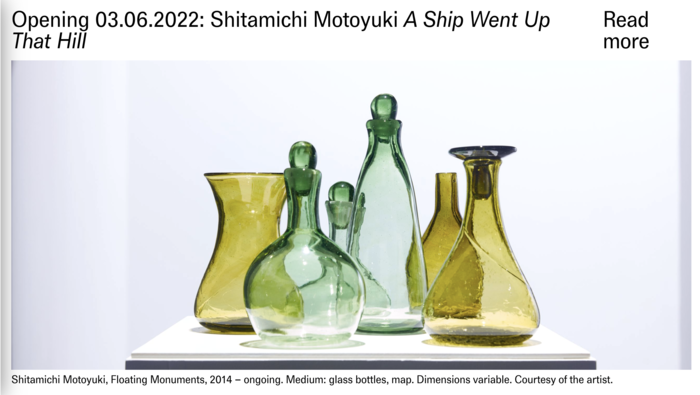Solo show
A Ship Went Up That Hill
Shitamichi Motoyuki
Kunsthal Aarhus
03.06.–07.08.2022
Guest Curator: Haeju Kim

https://kunsthalaarhus.dk/en/Exhibitions/Shitamichi-Motoyuki
Shitamichi Motoyuki (b. 1978, Japan) assembles and categorises things he sees, experiences and collects. He gathers fragments drifted from the strata of time, illuminates them under the light of the present and, in this way, connects the stories of the past to the here and now. This process manifests in the form of photographs and films as well as maps, objects and texts.
Following the archaeologist’s method, the artist explores the layers of time, with interest in which traces of the past remain in the present. He captures landscapes altered by natural disasters or urban development, collects fragile and fluid signs of artificially partitioned boundaries, and discovers everyday objects and stories behind mundane events.
After graduating from Musashino Art University, Tokyo, in 2001, for four years Shitamichi travelled all over Japan to capture traces of former military facilities, such as bunkers and forts, in a series of photographs entitled Remnants (2001–2005). He then travelled to Saipan, Tinian, Taiwan, Sakhalin and Korea to shoot Japanese shrine gates, which remain from Japan’s colonial period, for his Torii series (2006–2012). Rather than serving as direct evidence of the past, Shitamichi’s images encapsulate their present condition after a long period of time. His photographs show how traces of past events continuously change or disappear, like the essential state of memory.
A year after the 2011 Great East Japan Earthquake, the artist left Tokyo and moved to the Aichi region. One day, he happened across a small and beautiful river called Sakaigawa near his new house. The river, whose name literally translates to ‘Border River’, was also the boundary between the two provinces that governed the area long ago. Interested in this fact, Shitamichi began to interview people living by the river. As he found traces of borders buried in the name and topography of nature, ‘borders and boundaries’ gradually became the main subject of his work. The artist’s interest in the physical and, subsequently, psychological boundaries sensed in everyday life continues to the present. His research has since expanded to address a larger geography, as exemplified by Tsunami Boulder (2015–ongoing) – which is presented in this exhibition. This ongoing project is centred on the island of Okinawa, where geopolitical tensions permeate history. Capturing the massive rocks and boulders washed ashore by tsunamis, the work highlights the abrupt changes in scenery caused by natural disasters. Since 2013, Shitamichi has also been orchestrating a workshop-based project entitled 14 years old & the world & borders (2013–ongoing), working with teens at the threshold age of fourteen in different countries across the world.
Just before the outbreak of the coronavirus pandemic in 2020, the artist moved with his family to Naoshima, a small island in the inland sea of Setouchi, where he is still based. Here, every day he collects traces of the modern past, which he calls ‘new antiques’: everyday objects like matchboxes, bottles and tickets, which he incorporates into his work. He also holds various workshops with local residents in his studio, which serves as a library and commons. Working in close tandem with others, Shitamichi seeks to understand individuals, society and the world through a practice that attempts to reveal mundane but significant signs within everyday life, and invites us to rediscover the new values and perspectives they contain. As he explains, ‘I want to know the world in my own way, which is why I keep doing what I do.’